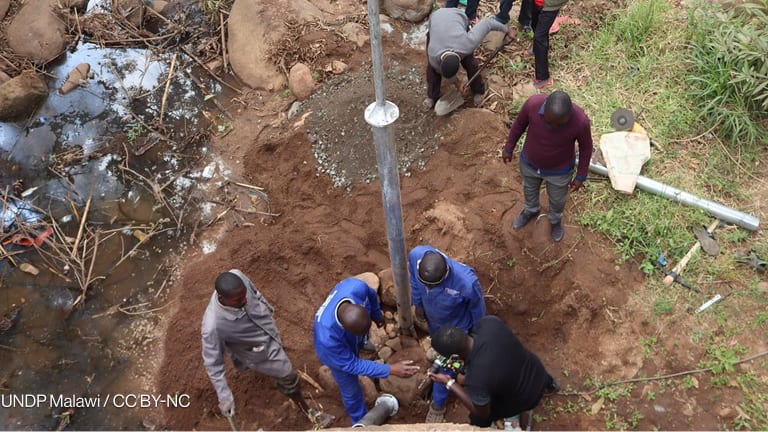
Resilience is a process, a way of thinking and acting — not just an end state.
And as leaders from 195 nations reached a landmark agreement in Paris on a framework to stop global climate change, we challenge nations to integrate climate resilience into development agendas.
Resilience building involves strengthening diverse connections and relationships — between people, communities, and the systems that support them — that enable communities to plan, prepare, and manage for change in times of increasingly complex and dynamic crises.
Operationalizing resilience in a context-specific and measurable way means evolving development programming design and implementation. Consideration of climate-induced shocks and stresses — along with shocks that are social, economic or ecological by nature — is essential.
Confronting the challenges
7 lessons for practitioners designing climate-resilient approaches
1. Incorporate climate change adaptation strategies across outcomes. Effective CRD programs integrate CCA across development strategies, rather than creating an isolated CCA program pillar. This ensures climate information informs all program strategies, and in turn, all outcomes.
2. Seek long-term strategies. Integration of climate adaptation within development strategies leads to larger scale and longer-term programs that bring together various organizations and partners across social, ecological and economic systems. Working within and around existing funding cycles requires sequencing and layering of projects so that they contribute to and build toward goals beyond the time-scale of any one activity.
3. Build a systemic understanding of climate challenges. Assessments and analysis conducted at the program design stage should be multidisciplinary and focused on how climate and nonclimate factors influence desired development outcomes. Siloed, sector-specific assessments are less effective for designing multiscale CRD programs.
4. Facilitate mainstreaming. The role of implementation agencies is to facilitate a process of learning, network-building and advocacy that supports and enables the mainstreaming of climate considerations into policy and planning. Mainstreaming climate within local systems, not programs, is the ultimate goal of CRD. This requires carefully targeted strategies aimed at growing and supporting the systems needed for climate resilience as opposed to providing services directly.
5. Enhance the capacity and knowledge of decision-makers. The ability of decision makers to understand climate risk and learn and adapt to new information is fundamental to CRD. Vulnerability assessments, adaptation planning, and pilot project development provide opportunities to build capacity and engagement among decision makers at multiple scales in government, civil society, and business sectors.
6. Target climate information dissemination. To integrate CCA strategies effectively, decision-makers — including government and market actors, community members, and project teams — must be able to access and interpret climate information quickly and easily. Climate and weather information must be user specific, time appropriate, accessible and targeted to identified needs.
7. Monitor climate information from design to evaluation. Climate vulnerability assessments are essential tools for informing program design and understanding the impacts of climate shocks and stresses. Analysis of climate disturbances should extend beyond design phases to monitoring and evaluation efforts.
One major challenge development actors face when attempting to operationalize resilience is effectively integrating climate adaptation strategies into broader development programming. Many of the people we target engage in livelihood strategies that are dependent on natural resources, often in arid and degraded environments. This limits their productivity and makes them even more vulnerable to shifts in climate and erratic weather patterns.
Such populations often have an extremely low capacity to prepare for and manage climate shocks and stresses, in part because governments are often unable to plan, adequately fund, or implement adaptation measures. Climate-induced hazards — including shorter or nonexistent seasonal rains, groundwater salinization and depletion, and humanitarian disasters — have a grave impact on already vulnerable communities. These hazards magnify existing development barriers and degrade development legacies; development professionals and the communities they work with have witnessed extreme and often unpredictable weather patterns on all continents.
These patterns damage social, economic, and ecological systems at multiple scales and give rise to new hazards. The increased frequency and intensity of weather-induced hazards exacerbate drivers of fragility, limit development, and drive involuntary migration and conflict across the least developed and most crisis-affected nations.
By threatening essential inputs for economic prosperity and human well-being, climate instability challenges our assumptions about security and livelihoods, especially for vulnerable communities at the center of development work. While it is increasingly clear that climate and related ecological factors are among the root causes of complex social and economic challenges, the development community struggles to address these drivers effectively.
A development-first approach?
Climate change is often perceived as too long-term a challenge, distinct from shorter-term project-based approaches to development outcomes, such as improved health, economic prosperity, agricultural productivity, and inclusive governance. Yet, allocating comparatively limited resources toward climate-related development programming and failing to integrate this programming across development efforts will dramatically hinder long-term achievement and return on investment.
Many practitioners and donors now advocate for a “development-first” approach that aims to build climate resilience through strategies that reduce poverty, including measures aimed at increasing food security, enhancing social cohesion, and strengthening governance inclusive of those now marginalized and impoverished. However, little on-the-ground experience on how to do this effectively currently exists.
As part of our broader Resilience Initiative, Mercy Corps conducted a series of case studies of programs attempting to integrate climate considerations to explore the approaches and experience to date. These case studies feature programming in partnership with a range of organizations, including CARE, the Caucasus Environmental NGO Network, and the Institute for Social and Environmental Transition.
Looking ahead to the next climate talks in 2016 and beyond, we challenge humanitarian and development donors and implementers to increase the commitments to integrating climate risk analysis and adaptation objectives across all investments. Climate change can no longer be isolated from other drivers of poverty and development challenges; we should ensure all future development outcomes are climate resilient.
Join the Devex community and access more in-depth analysis, breaking news and business advice — and a host of other services — on international development, humanitarian aid and global health.








